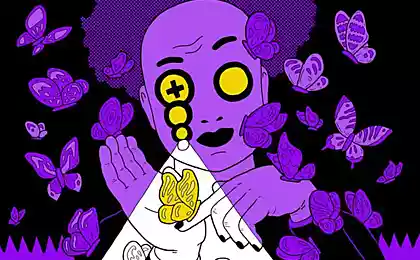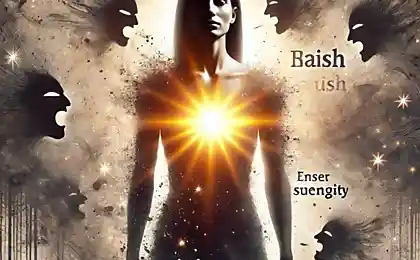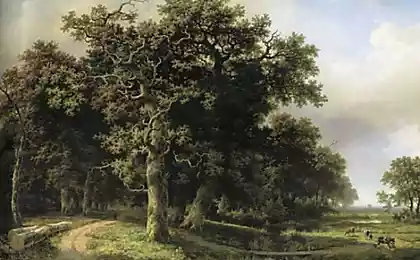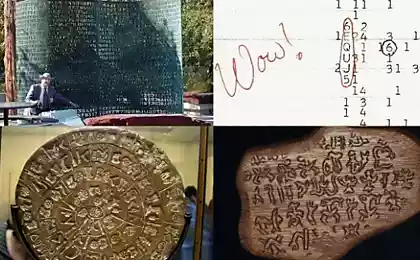571
Hard to be a Bosch: how to decipher the symbolism of the artist
Eighteen million three hundred nine thousand nine hundred forty eight
Faced with chaos, we instinctively seek to find in it some order, and if it fails — restore order themselves. For the specialist in medieval iconography bizarre works of Hieronymus Bosch not only a professional challenge, but also a temptation: how to hold in check the raging imagination? For others, a lesson: how to search for hidden values to use common sense and not to succumb to pseudo-scientific fantasies. Puzzle Paradise In the Madrid Museum Prado for sale puzzle of 9000 elements. As the colored spots are formed in shapes that appear naked beloved in a transparent sphere; rock, resembling the shoots of prickly plants; sinking into the cyclopean fruit; two "dancer" whose torsos and heads are hidden inside the red fruit, on which sits an owl; people defecate pearls, lying in a huge shell, etc. All they characters of "the Garden of earthly delights", which is Dutch artist Jeroen (Jerome) van aken, who took the nickname Bosch (named after the hometown of Chersonesos), written shortly after 1500.
Trying to understand what is the idea of "the Garden of earthly delights," what is the meaning of individual scenes and that symbolize all sorts of weird hybrids, which Bosch is famous, the researcher is also in a sense trying to put together a puzzle, only in front of him is no ready-made sample, and he does not know what needs to happen in the end.
Bosch is really a great strategist. His ingenuity is impressive even against the background of medieval art, which he plays and replays, and it knew a lot about visual and permutatio forms: from wild animals involved in the German ornament, to demons rocks with capitals of columns in Romanesque monasteries pores, animalistic and anthropomorphic hybrids, collobrative on the margins of Gothic manuscripts, to freaks and monsters carved on the seats-Misericordia that the clergy could sit during the long service. Bosch, which is out of this world came out, clearly it does not fit entirely to him is not reducible. So around his images decades raging controversy historians, and contrasting interpretations are innumerable. Erwin Panofsky, one of the greatest art historians of the twentieth century, wrote about Hieronymus Bosch: "We drilled a few holes in the door of a closed room, but the key to it, haven't picked up".
A bunch lucasa the last hundred years there have been many interpretations of Bosch's works. Ultracetbuy Bosch, a Catholic fanatic, obsessed with the fear of sin, argues with Bosch-a heretic, a follower of the esoteric teachings glorifying the joys of the flesh, and Bosch-clerical, almost protoprotestant, who could not endure the promiscuous, greedy and hypocritical clergy. Bosch-moralist, satirically sablechase the vices inherent in man, and ineradicable sinfulness of the world, competing with Bosch-skeptic, who probably mocked the stupidity and gullibility of mankind (as one Spanish poet of the XVI century, Bosch has succeeded in caricatures of devils, although he did not believe in them). Somewhere nearby is the alchemical Bosch — if not a practitioner, a connoisseur of alchemical symbols and the interpreter, the visual language of alchemical concepts. Don't forget about the Bosch-the madman, the Bosch pervert and Bosch-on-hallucinogens and psychoanalytic Bosch, which supplies inexhaustible material for speculation about the archetypes and the collective unconscious. All these faces of Jeroen van Aken — some of them fanciful (like Bosch-a heretic), while others (like Bosch-the moralist, or religious, Bosch) rather close to the truth — not always mutually exclusive and easily combined in different proportions.
Erwin Panofsky in the 1950s, the years lamented the fact that we still don't have a key to the Bosch. The key — metaphor is familiar, but evasive. It usually implies (though Panofsky, I think it's not meant) that there is some kind of a master key, a key principle or secret, which will look, and then all will become clear. In fact — if we use the metaphors — in one door can be a lot of locks, and one door — the next, and so on.
But if you look not with the keys, and hiccups, then any interpretation of the stumbles, first of all, the plot is the Central panel of "the Garden of earthly delights" — none of his contemporaries or predecessors Bosch nothing like it (although separate figures of lovers and of the gardens of Paradise c fountains abound). What kind of men and women indulge in carnal pleasures, eat a huge fruit, somersault and indulge in many strange occupations for which there is simply no titles?
Eighty nine million one hundred eighty thousand six hundred three
There are two conflicting interpretations — each with its pederseni, divergent in details. The first, which is shared by the majority of bogovalov, is that before us not the garden of Eden, and the illusive, deceptive Paradise; an allegory of various earthly vices (lust in the Chapter); blind joy of sinners who condemn themselves to death, the right wing of the triptych just shows prepared for them hell. Ernst Gombrich, elaborating on this idea, suggested that Bosch has painted a timeless allegory, and an antediluvian humanity — sinful descendants of Adam and eve, which so angered God that he destroyed them, not including Noah and his family, the waters of the flood (according to a widespread view that before the flood the earth was incredibly fertile — hence, according to Gombrich, fruit giant size). Naked people seem so joyful and carefree, because they know not what they do.
For a second, competing version, we do not see the false, diabolical, and the most that neither is a true Paradise, or Golden age, which is either utopian aspiration in the future (in ideal state of man) or, as suggested by Jean Wirth and Hans Belting, in General, lies outside time, because it never existed and will never occur. It is a kind of virtual Paradise: picture-perfect world in which the descendants of Adam and eve could live, if their ancestors had not sinned and was expelled from Eden, a sinless anthem of love (because no sin would not be) and nature, which would be generous to the man.
In favor of both interpretations is iconographic arguments. But sometimes there are theories that almost have nothing to show, that does not prevent them to gain popularity.
Any artist and they exist in some context. Dutch masters of the XV–XVI century, who wrote largely on Christian themes (and Bosch still primarily a moralist, the author of the gospel of scenes and images of saints-ascetics), is a medieval Church iconography with its traditions; the Latin Church the wisdom (from theological treatises to collections of sermons); the literature on national languages (from chivalry to ribald rhymes); scientific texts and illustrations (from the cosmologies and to the bestiaries, treatises on astrology and alchemy) and so on.
All of them interpreters Bosch asked for advice. Someone can say that the key to his symbols one should look for in, say, the teachings of the Cathars, which by the turn of XV–XVI centuries long since gone. Theoretically this could be. But the hypothesis esoterica and the more assumptions it requires, the more it should be treated.
Ninety nine million five hundred nine thousand eight hundred fifty five
At the time, a lot of fuss about the theory of German art historian Wilhelm Franger, who portrayed Bosch as a heretic and an adept of secret sexual cult. He argued that Jerome van aken was a member of the Brotherhood of the free spirit sect, which in recent times were mentioned in the Netherlands in the early fifteenth century. Its adherents believed to be dreamed of returning to the state of innocence in which Adam was before the fall (hence their name — Adamites), and think that you will be able to achieve through a love of exercise, which saw no lechery, and prayer, glorifying the Creator. If so, then love joy, holding the characters of "the Garden of earthly delights", according to Fringer, this is not a denunciation of sinful humanity, and a visual ode to carnal love and almost realistic depiction of the rituals of the sect.
To prove his theory, Finger builds one guess to another, and we know nothing about the presence of the Adamites in Harchongese. Biography of Bosch, except for a few documented administrative milestones (marriage, the lawsuit, death), is a solid white spot. However, we do know that he was a member of the prosperous in the city the Catholic Fraternity of the mother of God, received orders from the Church, and in the XVI century several of his works, including the frivolous "the Garden of earthly delights", has acquired the Spanish king Philip II, who were fanatically pious, and unlikely to be tolerated in the Escorial, the Shrine of the heretics-Adamites. Of course, you can always say that the heretical sense of the triptych was available only to the initiated, but for this Fringer followers are clearly arguments is not enough.
It has long been observed that many of the details by Hieronymus Bosch, from strange fountains to the glass cylinder, translucent spheres to the weird round buildings, of which one could see flashes of flame, painfully reminiscent of the vessels, furnaces and other alchemical tools, which were depicted in the treatises on the art of distillation. In the XV–XVI century, alchemy was not only esoteric knowledge, aimed at finding the elixir of life and the redemption of the world and man, but also quite practical craft (from him then came chemistry) required, for example, for the preparation of medical potions.
American historian of art Larenda Dixon went further and tried to prove that alchemy is the key to everything "the Garden of earthly delights". According to her version, Bosch, picking up popular among alchemists allegory, likens the transformation of the man, moving to the Mergence with God, the most important alchemical process of distillation. Traditionally it was believed that distillation consists of four main stages. Their sequence, according to Gibson, and defines the structure of the Garden.
Eighty one million one hundred nineteen thousand seven hundred twenty seven
The first stage is the mixing of the ingredients and the Union of opposites in the alchemical manuscripts presented as the Union of a man and woman, Adam and eve. This is the main plot of the left leaf of the Garden, where we see the marriage of the first people: the Lord presenting eve to Adam and blessed the first couple to be fruitful and multiply. The second stage is slow heating and the transformation of ingredients into a single mass — like jumps, tumbling and fun for children born in the alchemical marriage. Here is the story of the Central panel of the triptych, where a crowd of men and women humping away and strange games. The third stage is the purification of the mixture by the fire in the alchemical treatises symbolically presented as punishment or hell. On the right leaf of the "Garden" depiction of the fiery hell with dozens of different torture. Finally, the fourth stage — the cleansing of the ingredients in the water, which is likened to the Christian resurrection and cleansing of the soul. This is the story that we see on the exterior wings of the triptych, where the Land appears on the third day of creation, when the Creator separated the dry land from the sea, there were plants, but there was never a man.
Many findings of Dixon bribe their clarity. Bochove of the building and the glass tube is, indeed, too similar to the illustration of treatises on distillation, so that the resemblance was accidental. There is another problem: the similarity of the parts does not mean that the whole "Garden of earthly delights" is a huge alchemical metaphor. Bosch, as critics argue Dixon, could borrow the images of flasks, furnaces and alchemical lovers, not praising, and criticizing academic pseudomodest (if Paradise still false and of the devil), or using alchemical symbols as building material for their visual fantasies that served very different purposes: whipped animal passions or sang lost the purity of man.
Designer of smyslovoy figure out the meaning of some parts, it is important to trace its genealogy — but not enough. You should still understand how it fits into the new context and how it plays. In "the Temptation of St. Anthony", another triptych by Bosch, which is now kept in Lisbon in the sky floating white cableprice — create a front similar to a Heron, and at the rear of the ship with bird claws. Inside the ship the fire from which the smoke fly tiny birds. Bosch clearly loves this motif in "the Garden of earthly delights", the black birds, as if from an Inferno, appear from the backside of the wicked man devours potterology the devil is the master of the underworld.
Fifty two million four hundred forty one thousand seven hundred forty two
The French art historian Jurgis, Baltrusaitis at the time showed that this weird hybrid, like many others, invented long before Bosch. A similar karabatic known in ancient seals, which in the middle Ages, prized as amulets. And they are not portrayed mythical creatures, and real Greek or Roman ships with the nose in the shape of a Swan or other bird. What did Bosch, as it replaced the paddles with bird wings, moved karabatic from the ocean to the heavens and made it a hell of a small fire, turning it into one of the demonic apparitions encamped in the wilderness of St. Anthony.
Interpretations of such hybrids and their in medieval art before the Bosch was a lot — it's hard to say where the researcher has bottomed and when it's time to stop. Fascinated peering into bizarre creatures collected by Bosch of all conceivable materials, in his man-beasts, gregoryb and piccarella that blur the lines between the animate and inanimate nature, animals, plants and man, historians often interpretiruya on the principle of design. If the figure is made up of many elements, it is necessary to find out how they were used and how was interpreted in medieval iconography. Then to find out the meaning of the whole, assuming they have to add up the values of the parts. The logic overall is sound, but sometimes gets too far, as two plus two not always equal four.
Ninety six million fifty nine thousand sixty seven
Take one case. In the depths of the "Temptation of St. Anthony" big fish, "dressed" in the red "box" reminiscent of the back of the grasshopper, locust or Scorpion, a fish devouring another, smaller. Dirk Bax, one of the most authoritative interpreters of Bosch, has long shown that many of his images are constructed as a literal illustration for the Flemish Proverbs or idiomatic expressions are a kind of visual puzzles or materialized wordplay — his first audience she was probably clear, and we are most often slipping.
So voracious fish probably refers to the famous proverb "Big fish eat little", that is, the strong devour the weak, and the weak — weaker. Remember the illustration of Pieter Bruegel the Elder (1556), where ripped open the belly of a dead fish spilling dozens eaten by fishes, each mouth — smaller fish, and that is very tiny. The world is cruel. So perhaps our fish reminds about greed and gluttony.
But what are the remaining details: the insects legs and tail, blue concave shield, which this structure can slide, standing at his upstairs Gothic chapel and, finally, the demon (and maybe people), which with the help of the ropes pushes small fish in a big mouth? If we have the tail of Scorpio (although it is not known meant if Bosch is his), he is in the medieval texts were often associated c the devil, and in the life of St. Anthony just said that the demons have besieged the ascetic in the images of different animals and reptiles: lions, leopards, serpents, vipers, Scorpions. Times on the back of a monster stands a chapel, then, as suggested by commentators, this whole diabolical design exposes the greed of the Church.
All this is possible, and in the middle Ages can meet a myriad of examples of symbolic interpretations where the General sense of the whole (say, of the Church's architecture) consists of the sum of dozens of elements, each of which anything symbolizes. However, this does not mean that Bosch every detail was always a visual puzzle, and even more that just his contemporary, scanning gaze of the hundreds of figures that inhabit "the Garden of earthly delights" or "the Temptation of St. Anthony", was capable of all these meanings to count. Many of the details are clearly needed to create a demonic entourage and the kaleidoscope of forms, not for hidden game characters. When we are confronted with a strange, perepadet sometimes almost as bad as and no one noticed.
Popular interpretations of some of the images
Giant strawberries ("the Garden of earthly delights»)
Ninety five million six hundred thirty thousand eight hundred eighty seven
The first interpreter of strawberries became a Spanish monk josé de Siguenza is the author of the oldest surviving descriptions of a triptych (1605). Possibly in order to protect Bosch from accusations of promoting debauchery, he claimed that his frivolous scene, on the contrary, satirically expose human vices and strawberries (whose smell and taste is so fleeting) symbolizes the futility and vanity of earthly joys.
Although in the medieval texts of strawberries sometimes appeared positive associations (spiritual blessings which God gives the mystics, or the spiritual food that the righteous enjoy in heaven), it often symbolized sinful sexuality and the hidden dangers that lurk behind the pleasures (snake, ready to sting, who will break the berries). So, most likely, a giant strawberry indicates that the serenity of the people, indulging in frivolous games in the beautiful garden is a road to hell.
Glass pipes ("the Garden of earthly delights»)
Fifty five million two hundred eighty nine thousand three hundred forty three
Around the garden here and there scattered glass pipes, not like the fanciful creations of nature (as other strange objects around), and the work of human hands. It has been noticed that they more closely resemble the various devices of the chemical laboratory, and then work on the alchemical interpretation of the triptych in the spirit of Larinda Dixon.
However, not everyone agrees. Hans Belting believed that alchemical tube is more of a mockery of the vain attempts of the alchemists (or even person) to master the secrets of nature, to simulate them with the help of technical tricks and to resemble the Creator. And before him Ernst Gombrich, commenting on one of these "pipes" suggested (though not too convincingly) that this is not an alchemical device, and the column on which, according to one medieval legend, the people who lived before the flood and knew that the world would soon die, wrote down their knowledge.
Pig-nun ("the Garden of earthly delights»)
Fifty six million sixty one thousand four hundred ten
In the corner of the underworld pig with the monastic cap climbs with tenderness towards the scared man terrified otvorachivayutsya from her annoying nose. On his lap lies a document with two wax seals and the monster in the knight's armor poking his quill and inkwell.
According to one version, the pig forcing him to sign a will in favor of the Church (what in the hell, when the soul can not be saved, too little too late), and the whole scene exposes the greed of the clergy. Another (less convincing) is in front of us (parody) image of the Covenant with the devil.
Anyway, the attacks against the clergy does not mean that Bosch was an adherent to the heresy. The art of the late middle Ages is full of satirical and accusatory images of greedy and negligent priests, lustful monks, and ignorant bishops and anyone not think that their creators were like one artists-heretics.
Forty one million three hundred five thousand five hundred five
As suggested by Lorinda Dixon, this scene should be interpreted alchemically. In the treatises on distillation regularly depicts lovers in a rounded glass jar. It symbolizes one of the phases of the alchemical process, when elevated temperature is a connection of elements with opposite properties. They are metaphorically likened to a man and woman, Adam and eve, and their Union is carnal copulation. However, even if Dixon is right, and this motif is taken from the symbolism of alchemy, it is likely that Bosch has used it to create exotic surroundings, and not for the glorification of secret wisdom.
Foot-to-foot ("the Garden of earthly delights»)
Fifty four million one hundred four thousand eight hundred eighty
Leg of Adam, who the Lord is eve, created from his rib while he slept, somehow, lies at the foot of the Creator. Most likely, this piece literally illustrates the biblical metaphor of a godly life and obedience to God: "to walk in the ways of the Lord." In accordance with the same logic, in the middle Ages during the anointing (confirmation) receiving the sacrament of man, according to one version of the ritual, put your foot on the leg of the Bishop who had performed the sacrament.
The devil's feast ("the Temptation of St. Anthony»)
Six million four hundred thirty four thousand seventy five
It is clear that behind the back of St. Anthony (monks, which looks at us) something bad. But what? Someone is comparing a round table with the altar, said that in front of us, a black mass, or a diabolical parody of worship, where instead of the wafer, which pressestelle in the body of Christ, the tray is toad — one of the traditional symbols of the devil; somebody interpreterpath this scene through astrological symbols, while the engraving restless "children of the moon": gambling and various scams, crowding around the table with bones and cards.
The bird on skates ("the Temptation of St. Anthony»)
Ninety nine million eight hundred thousand nine hundred forty four
Eared the creation of an inverted funnel and sealed with wax letter, put on the beak, is one of the most famous boskovsky monsters. In the same funnel Bosch in another work depicted a con man doctor, extracting the stone of foolishness from his head naive patient.
Characters-skaters have it too much. In the middle of hell, on the right leaf of the "Garden of earthly delights", some human figures and humanoid furry duck cut on thin ice in the brandy or huge korkoobraznymi devices. According to archaeological findings, Bosch depicted the skates more than realistic. The question of what he meant. There is a version that skating symbolized the slippery slope, the fast track to destruction. But maybe it was just the skates.
Tree man with a rat-tail fish ("the Temptation of St. Anthony»)
Fifty eight million two hundred twenty eight thousand eight hundred eighty four
Bosch liked to play, a blend of animal and vegetable forms, but it's probably not just a visual game. Saint Anthony in the Middle ages was considered a protector against ergotism — a painful disease (leading to hallucinations and gangrene of the extremities), which was caused by the fungus ergot, a parasite on cereals, of which they made bread. This illness was called St. Anthony's fire or sacred fire.
One means of treatment in addition to prayer and miraculous Holy water, into which dipped the particles of his relics, — were considered as a cooling substance (e.g., fish) and Mandrake root, which sometimes resembles a human figure. Medieval herbals was portrayed as a tree-like man and in reality made him look human amulets, which were supposed to protect from the flames of the disease.
So the tree man with the rat tail, covered with fish scales, is not just a figment of the imagination of Bosch, but, as suggested by Lorinda Dixon, the personification of cure for ergotism or one of the hallucinations associated with this disease.
List istochnikovedenie V. Hieronymus Bosch. Circa 1450-1516. Between heaven and hell. Moscow, 2001.
Marijnissen R. H., Revelare P. Hieronymus Bosch. Artistic heritage. Moscow, 1998.
J. Baltrušaitis, Le Moyen Âge fantastique. Paris, 1956.
H. Belting Hieronymus Bosch. Garden of Earthly Delights. New York, 2002.
Bax D. Hieronymus Bosch: His Picture-Writing Deciphered. Rotterdam, 1979.
Dixon L. Bosch. New York, 2003.
W. Fraenger, The Millennium of Hieronymus Bosch. London, 1952.
Gombrich E. H. Bosch''s "Garden of Earthly Delights": A Progress Report // Journal of the Warburg and Courtauld Institutes, 1969, Vol. 32.
Wirth J., Le Jardin des délices de Jérôme Bosch // Bibliothèque d ' Humanisme et Renaissance, 1988, T. 50, no. 3.
Source: theoryandpractice.ru























